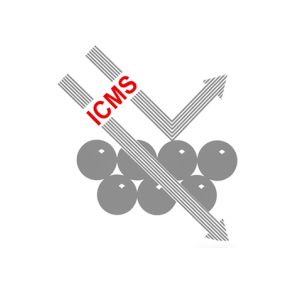Scientific Papers in SCI
2021
2021
Materiales de Diseño para la Energía y Medioambiente
Swelling layered minerals applications: A solid state NMR overview
Pavon, E; Alba, MDProgress in Nuclear Magnetic Resonance Spectroscopy, 124 (2021) 99-128 DOI: 10.1016/j.pnmrs.2021.04.001
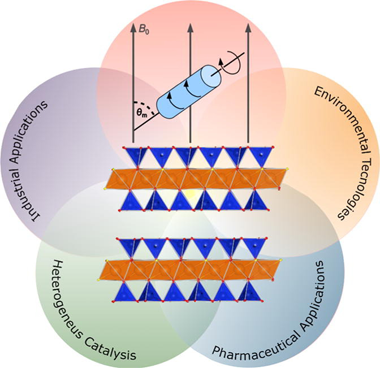
Abstract
Swelling layered clay minerals form an important sub-group of the phyllosilicate family. They are characterized by their ability to expand or contract in the presence or absence of water. This property makes them useful for a variety of applications, ranging from environmental technologies to heteroge-neous catalysis, and including pharmaceutical and industrial applications. Solid State Nuclear Magnetic Resonance (SS-NMR) has been extensively applied in the characterization of these materials, providing useful information on their dynamics and structure that is inaccessible using other characterization methods such as X-ray diffraction. In this review, we present the key contributions of SS-NMR to the understanding of the mechanisms that govern some of the main applications associated to swelling clay minerals. The article is divided in two parts. The first part presents SS-NMR conventional applications to layered clay minerals, while the second part comprises an in-depth review of the information that SS-NMR can provide about the different properties of swelling layered clay minerals.
June, 2021 · DOI: 10.1016/j.pnmrs.2021.04.001
Materiales de Diseño para la Energía y Medioambiente
Structural Evolution in Iron-Catalyzed Graphitization of Hard Carbons
Gomez-Martin, A; Schnepp, Z; Ramirez-Rico, JChemistry of Materials, 33 (2021) 3087-3097 DOI: 10.1021/acs.chemmater.0c04385
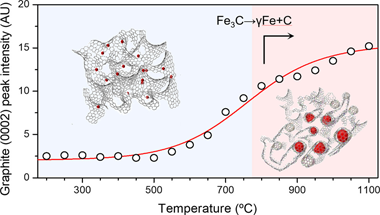
Abstract
Despite the recent interest in catalytic graphitization to obtain graphite-like materials from hard-carbon sources, many aspects of its mechanism are still poorly unknown. We performed a series of in situ experiments to study phase transformations during graphitization of a hard-carbon precursor using an iron catalyst at temperatures up to 1100 degrees C and ex situ total scattering experiments up to 2000 degrees C to study the structural evolution of the resulting graphitized carbon. Our results show that upon heating and cooling, iron undergoes a series of reductions to form hematite, magnetite, and wustite before forming a carbide that later decomposes into metallic iron and additional graphite and that the graphitization fraction increases with increasing peak temperature. Structural development with temperature results in decreasing sheet curvature and increased stacking, along with a decrease in turbostratic disorder up to 1600 degrees C. Higher graphitization temperatures result in larger graphitic domains without further ordering of the graphene sheets. Our results have implications for the synthesis of novel biomass-derived carbon materials with enhanced crystallinity.
May, 2021 · DOI: 10.1021/acs.chemmater.0c04385
Materiales Avanzados
Synthesis of clay geopolymers using olive pomace fly ash as an alternative activator. Influence of the additional commercial alkaline activator used
Gomez-Casero, MA; Moral-Moral, FJ; Perez-Villarejo, L; Sanchez-Soto, PJ; Eliche-Quesada, DJournal of Materials Research and Technology-JMR&T 12 (2021) 1762-1776 DOI: 10.1016/j.jmrt.2021.03.102
Abstract
In this research, the use of olive pomace fly ash (OPFA) as an alkaline source for the activation of calcined clays (CC) from Bailen (Jaen, Spain) was studied. The optimal composition was obtained for 70 wt % CC and 30 wt % OPFA. The physical, mechanical and thermal properties of control geopolymers that use water as a liquid medium have been studied and compared with geopolymers that use additional activating solutions as sodium or potassium hydroxide solutions (8 M), or a mixture of alkaline hydroxide and alkaline silicate solution (NaOH-Na2SiO3 or KOH-K2SiO3). The results showed that OPFA can be used as an alkaline activator, showing mechanical properties slightly lower than those obtained when additional alkaline hydroxide activating solutions were used. The best compressive strength was obtained for geopolymers that use alkaline silicates as an activating solution. However, the best thermal insulation properties were obtained for control geopolymers. The microstructural characteristics of the geopolymers were evaluated by means of X-ray diffraction (XRD), Fourier transform infrared (FTIR) spectroscopy and Scanning Electron Microscopy (SEM-EDS) that corroborate the formation of geopolymeric gel in all the specimens, being the amount of gel formed greater in samples using commercial potassium activating solutions. These results demonstrate the feasibility of using this type of waste, OPFA, as activating reagents in the manufacture of geopolymers or alkaline activated materials. The manufactured geopolymers can be used as compressed earth blocks for walls and partitions, since the specimens pursue mechanical properties that comply with current regulations, presenting better thermal insulation properties.
May, 2021 · DOI: 10.1016/j.jmrt.2021.03.102
Química de Superficies y Catálisis
Understanding the opportunities of metal-organic frameworks (MOFs) for CO2 capture and gas-phase CO2 conversion processes: a comprehensive overview
Gandara-Loe, J; Pastor-Perez, L; Bobadilla, LF; Odriozola, JA; Reina, TRReaction Chemistry & Engineering, 6 (2021) 787-814 DOI: 10.1039/d1re00034a

Abstract
The rapid increase in the concentration of atmospheric carbon dioxide is one of the most pressing problems facing our planet. This challenge has motivated the development of different strategies not only in the reduction of CO2 concentrations via green energy alternatives but also in the capture and conversion of CO2 into value-added products. Metal-organic frameworks (MOFs) are a relatively new class of porous materials with unique structural characteristics such as high surface areas, chemical tunability and stability, and have been extensively studied as promising materials to address this challenge. This comprehensive review identifies the specific structural and chemical properties of MOFs that result in advanced CO2 capture capacities and fairly encouraging catalytic CO2 conversion behaviour. More importantly, we describe an interconnection among the unique properties of MOFs and the engineering aspects of these intriguing materials towards CO2 capture and conversion processes.
May, 2021 · DOI: 10.1039/d1re00034a
Mössbauer study of iron gall inks on historical documents
Lerf, A; Wagner, FE; Dreher, M; Espejo, T; Perez-Rodriguez, JLHeritage Science, 9 (2021) 49 DOI: 10.1186/s40494-021-00522-3
Abstract
Iron gall ink was used in the Western world as a permanent writing material already in late Roman times and throughout the Middle Ages, until it became obsolete in the twentieth century. There is much interest in experimental methods to determine the state of the ink and its degradation products on historical documents. Mossbauer spectroscopy with Fe-57 is such a method, and it has the particular advantage to be sensitive to the chemical bonding of iron, but this method has only rarely been applied to historical documents. In this paper we present Mossbauer data for two damaged documents from a Library in Granada and a handwritten German book from the eighteenth century. In addition to the inked parts of the manuscripts, ink-free parts were studied to determine the amount and chemical state of the iron in the papers. These new results are discussed in the context of previously published Mossbauer data. In one of the investigated documents Fe(II)-oxalate, FeC2O4 center dot 2H(2)O, was observed. The assignment of the various Fe3+ sites in the different documents is rather difficult and often there is a superposition of various species. Known forms of iron gallate are definitely not present on the inked papers. The observed ferric species can be remains of Fe3+ polyphenol complexes of the ink, complexes of Fe3+ with degradation products of the cellulose of the paper or gum arabic, or very small iron oxide or hydroxide nanoparticles.
May, 2021 · DOI: 10.1186/s40494-021-00522-3
Tribología y Protección de Superficies - Materiales Ópticos Multifuncionales
High-temperature solar-selective coatings based on Cr(Al)N. Part 1: Microstructure and optical properties of CrNy and Cr1-xAlxNy films prepared by DC/HiPIMS
Rojas, TC; Caro, A; Lozano, G.; Sanchez-Lopez, JCSolar Energy Materials and Solar Cells, 223 (2021) 110951 DOI: 10.1016/j.solmat.2020.110951
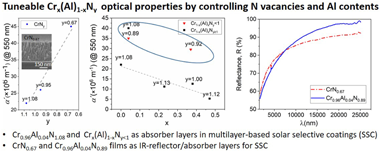
Abstract
In order to explore the potentialities of Cr1-x(Al)xNy materials in multilayer-based solar selective coatings (SSC) for high temperature applications (T > 500 °C), the optical behavior of Cr1-x(Al)xNy films is studied in this work. Two sets of layers (CrNy and Cr1-xAlxNy) were prepared by direct current (DC) and high-power impulse magnetron sputtering (HiPIMS) technology. The deposition parameters: N2 flux, HiPIMS frequency and aluminum sputtering power, were modified to get a wide variety of stoichiometries. The composition, morphology, phases and electronic structure of the films were characterized in depth. The optical behavior was determined by UV–Vis–NIR and FTIR spectroscopies, and the optical constants were obtained from the measured transmittance and reflectance spectra based on appropriate dielectric function models. Our results indicate that small changes in the layer composition influence the optical constants. In particular, a metallic-like behavior was obtained for CrNy layers with N vacancies (CrN0.95 and CrN0.67 films) while a semiconductor-like behavior was observed for CrN1.08. Thus, the CrNy films can be used as effective absorber layer in multilayer-based SSC, and namely, the CrN0.67 film as an IR reflector/absorber layer too. Likewise, the optical properties of Cr1-xAlxNy layers can also be tuned from metallic to semiconductor-like behavior depending on the chemical composition. Indeed, the absorption coefficients of Cr1-xAlxNy films with optimized Al content and N-vacancies are comparable to those reported for state-of-the-art materials such as TiAlN or TiAlCrN. In addition, a Cr0.96Al0.04N0.89 film was found to be a suitable IR reflector/absorber layer.
May, 2021 · DOI: 10.1016/j.solmat.2020.110951
Reactividad de Sólidos
Synthesis and Characterization of a Nearly Single Bulk Ti2AlN MAX Phase Obtained from Ti/AlN Powder Mixture through Spark Plasma Sintering
Salvo, C; Chicardi, E; Poyato, R; Garcia-Garrido, C; Jimenez, JA; Lopez-Pernia, C; Tobosque, P; Mangalaraja, RVMaterials, 14 (2021) 2217 DOI: 10.3390/ma14092217
Abstract
MAX phases are an advanced class of ceramics based on ternary carbides or nitrides that combine some of the ceramic and metallic properties, which make them potential candidate materials for many engineering applications under severe conditions. The present work reports the successful synthesis of nearly single bulk Ti2AlN MAX phase (>98% purity) through solid-state reaction and from a Ti and AlN powder mixture in a molar ratio of 2:1 as starting materials. The mixture of Ti and AlN powders was subjected to reactive spark plasma sintering (SPS) under 30 MPa at 1200 degrees C and 1300 degrees C for 10 min in a vacuum atmosphere. It was found that the massive formation of Al2O3 particles at the grain boundaries during sintering inhibits the development of the Ti2AlN MAX phase in the outer zone of the samples. The effect of sintering temperature on the microstructure and mechanical properties of the Ti2AlN MAX phase was investigated and discussed.
May, 2021 · DOI: 10.3390/ma14092217
Química de Superficies y Catálisis
Effect of the sulphonating agent on the catalytic behavior of activated carbons in the dehydration reaction of fructose in DMSO
Bounoukta, CE; Megias-Sayago, C; Ivanova, S; Penkova, A; Ammari, F; Centeno, MA; Odriozola, JAApplied Catalysis A-General, 617 (2021) 118108 DOI: 10.1016/j.apcata.2021.118108
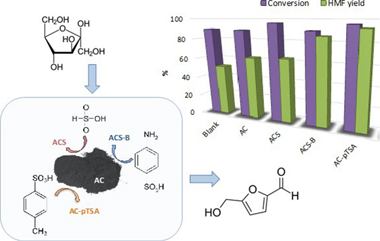
Abstract
A series of -SO3R functionalized activated carbons (R=H, O, aryl) were prepared and applied in fructose dehydration reaction to 5-hydroxymethylfurfural. Different sulphonating methods introduce groups on catalyst surface with distinct donor-acceptor and hydrophilic properties. Their nature influences significantly not only activated carbon?s textural and chemical properties but also the product yields and selectivity in fructose dehydration reaction. The viability of the solvent free reaction was also investigated and compared to the performance of the catalyst series in presence of DMSO, where the best catalytic results were obtained.
May, 2021 · DOI: 10.1016/j.apcata.2021.118108
Materiales Avanzados
Effects of an Illite Clay Substitution on Geopolymer Synthesis as an Alternative to Metakaolin
Eliche-Quesada, D; Bonet-Martinez, E; Perez-Villarejo, L; Castro, E; Sanchez-Soto, PJJournal of Materials in Civil Engineering, 33 (2021) 04021072 DOI: 10.1061/(ASCE)MT.1943-5533.0003690
Abstract
In this study, a calcined illite clay from Bailen, Jaen, Spain, was valorized as a substitute of metakaolin in the synthesis of new geopolymeric materials. The raw materials, raw clay and commercial kaolin, were pretreated at 750 degrees C (4 h). Several samples (0%-100% by weight of clay) were activated by mixing NaOH solution and sodium silicate solution. The specimens were cured (60 degrees C and 99% relative humidity) for 24 h, then demolded and kept at ambient conditions for 7, 28, and 90 days. The prepared geopolymers were characterized by X-ray diffraction, Fourier transform infrared spectroscopy, and scanning electron microscopy. Physical, mechanical, and thermal properties were determined. The results indicated that the specimens based on the illite raw clay and metakaolin present an amorphous consolidated appearance, characteristic of the polycondensation reactions. The incorporation of up to 50% by weight of raw clay provided geopolymers with higher mechanical strength (39.6 MPa) and bulk density (1,455 kg/m(3)), lower apparent porosity (19.6%), and similar although slightly higher thermal conductivity (0.25 W/mK) than control geopolymers containing only metakaolin as a precursor after 28 days of curing. Control geopolymers presented compressive strength, bulk density, apparent porosity, and thermal conductivity of 23 MPa, 1,251 kg/m(3), 41.03% and 0.224 W/mk, respectively, at the same age of cured geopolymers. The mechanical properties increased with curing time due to a greater advance of the geopolymerization reaction. Therefore, this illite clay can be thermally activated together with metakaolin to obtain geopolymers with suitable technological properties. The results demonstrate that the finished materials can be used for construction applications.
May, 2021 · DOI: 10.1061/(ASCE)MT.1943-5533.0003690
Química de Superficies y Catálisis
IR spectroscopic insights into the coking-resistance effect of potassium on nickel-based catalyst during dry reforming of methane
Azancot, L; Bobadilla, LF; Centeno, MA; Odriozola, JAApplied Catalysis B-Environmental, 285 (2021) 119822 DOI: 10.1016/j.apcatb.2020.119822
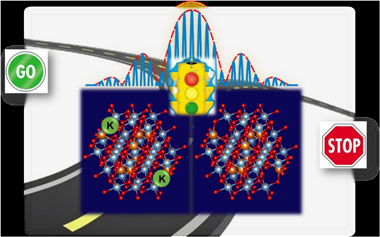
Abstract
Dry reforming of methane (DRM) is an effective catalytic route for transforming CO2 and CH4 into valuable syngas and thus potentially attractive for mitigating the emission of environmental harmful gases. Therefore, it is crucial to develop rationally Ni-based catalysts highly resistant to coking and sintering. In this scenario, the addition of small amounts of potassium to nickel catalyst increases their resistance to coking during dry reforming of methane. Nonetheless, the specific role of potassium in these catalysts not have been fully understood and there are still important discrepancies between the different reported studies. This work provides a new approach on the anticoking nature of a K-promoted Ni catalyst by means of a combined IR spectroscopic study of in situ characterization by CO adsorption under static conditions and operando DRIFTS measurements under dynamic conditions of DRM reaction. The involved surface species formed during the reaction were elucidated by transient and steady-state operando DRIFTS studies. It was revealed that the existence of Ni-K interfacial sites favours the gasification of carbonaceous deposits towards reverse Boudouard reaction and reduces the sticking probability of CO2 dissociative adsorption. Moreover, the presence of strongly Mg-O-K basic sites leads to the formation of carbonate intermediates that are subsequently reduced into CO gaseous towards the associative mechanism by RWGS reaction. These results provide a fundamental understanding of the relevant anticoking effect of potassium on Ni-based catalysts.
May, 2021 · DOI: 10.1016/j.apcatb.2020.119822
Reactividad de Sólidos
Mechanochemically synthesized ternary chalcogenide Cu3SbS4 powders in a laboratory and an industrial mill
Dutkova, E; Sayagues, MJ; Fabian, M; Balaz, M; Achimovicova, MMaterials Letters, 291 (2021) 129566 DOI: 10.1016/j.matlet.2021.129566

Abstract
In this work, we demonstrate the use of elemental precursors (Cu, Sb, S) to synthesize famatinite Cu3SbS4 using a laboratory planetary ball milling and an industrial eccentric vibratory milling. Cu3SbS4 was prepared for 120 min and 180 min in laboratory and industrial mill, respectively, with the utilization of protective atmosphere. The Cu3SbS4 prepared in the laboratory and industrial mill with crystallite size 14 nm and 10 nm, respectively, was confirmed by both LeBail refinement of the X-ray powder diffraction data and transmission electron microscopy. The determined band gap energy 1.31 eV and 1.24 eV is blue-shifted relative to the bulk Cu3SbS4. The synthesis of Cu3SbS4 by a scalable milling process represents a prospective route for mass production of material with potential photovoltaic properties. In this work, we demonstrate the use of elemental precursors (Cu, Sb, S) to synthesize famatinite Cu3SbS4 using a laboratory planetary ball milling and an industrial eccentric vibratory milling. Cu3SbS4 was prepared for 120 min and 180 min in laboratory and industrial mill, respectively, with the utilization of protective atmosphere. The Cu3SbS4 prepared in the laboratory and industrial mill with crystallite size 14 nm and 10 nm, respectively, was confirmed by both LeBail refinement of the X-ray powder diffraction data and transmission electron microscopy. The determined band gap energy 1.31 eV and 1.24 eV is blue-shifted relative to the bulk Cu3SbS4. The synthesis of Cu3SbS4 by a scalable milling process represents a prospective route for mass production of material with potential photovoltaic properties.
May, 2021 · DOI: 10.1016/j.matlet.2021.129566
Materiales Ópticos Multifuncionales
Toward Commercialization of Stable Devices: An Overview on Encapsulation of Hybrid Organic-Inorganic Perovskite Solar Cells
Aranda, Clara A.; Calio, Laura; Salado, ManuelCrystals, 11 (2021) 519 DOI: 10.3390/cryst11050519
Abstract
Perovskite solar cells (PSCs) represent a promising technology for energy harvesting due to high power conversion efficiencies up to 26%, easy manufacturing, and convenient deposition techniques, leading to added advantages over other contemporary competitors. In order to promote this technology toward commercialization though, stability issues need to be addressed. Lately, many researchers have explored several techniques to improve the stability of the environmentally-sensitive perovskite solar devices. Challenges posed by environmental factors like moisture, oxygen, temperature, and UV-light exposure, could be overcome by device encapsulation. This review focuses the attention on the different materials, methods, and requirements for suitable encapsulated perovskite solar cells. A depth analysis on the current stability tests is also included, since accurate and reliable testing conditions are needed in order to reduce mismatching involved in reporting the efficiencies of PSC.
May, 2021 · DOI: 10.3390/cryst11050519
Fotocatálisis Heterogénea: Aplicaciones
Fluorinated and platinized Titania for Glycerol oxidation
Murcia, J.J.; Bautista, E; Ávila Martínez, E.G.; Rangel R.N.; Romero, R.; Cubillos Lobo, J.A.; Rojas Sarmiento, H.A.; Hernández, J.S.; Cárdenas, O.; Hidalgo, M.C.; Navío, J.A.; Baeza, R.Materials Proceedings, 4 (2021) 37 DOI: 10.3390/IOCN2020-07792
Abstract
In this research, photocatalysts based on TiO2 modified by fluorination and platinum addition were evaluated in the glycerol oxidation. These materials were characterized by different instrumental analysis techniques to determine the physicochemical properties. It was found that the surface modification lead to improve the materials absorption in the Visible region of the electromagnetic spectra and to increase the surface area of TiO2. By HPLC analysis was possible to observed that the photocatalysts 0.5% Pt-F-TiO2 showed the highest yield and selectivity towards glyceraldehyde (GAL). It was also observed that the increase in the platinum content until values of 2% had a negative effect in the effectiveness of fluorinated Titania in the glycerol photo-oxidation. The fluorination and platinum addition modify some physicochemical properties of TiO2, leading also to modify the reaction mechanism and selectivity during glycerol partial photo-oxidation and the dose of photocatalysts is an important reaction condition to obtain GAL and Dyhidroxyacetone (DHA) with yields above to 70%.
April, 2021 · DOI: 10.3390/IOCN2020-07792
Materiales Coloidales
Holmium phosphate nanoparticles as negative contrast agents for high-field magnetic resonance imaging: Synthesis, magnetic relaxivity study and in vivo evaluation
Gomez-Gonzalez, E; Caro, C; Martinez-Gutierrez, D; Garcia-Martin, ML; Ocana, M; Becerro, AIJournal of Colloid and Interface Science, 587 (2021) 131-140 DOI: 10.1016/j.jcis.2020.11.119
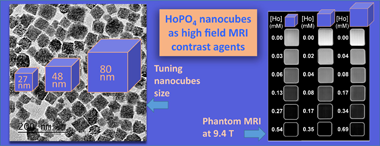
Abstract
The increasing use of high magnetic fields in magnetic resonance imaging (MRI) scanners demands new contrast agents, since those used in low field instruments are not effective at high fields. In this paper, we report the synthesis of a negative MRI contrast agent consisting of HoPO4 nanoparticles (NPs). Three different sizes (27 nm, 48 nm and 80 nm) of cube-shaped NPs were obtained by homogeneous precipitation in polyol medium and then coated with poly(acrylic) acid (PAA) to obtain stable colloidal suspensions of HoPO4@PAA NPs in physiological medium (PBS). The transverse relaxivity (r2) of aqueous suspensions of the resulting NPs was evaluated at both 1.44 T and 9.4 T. A positive correlation between r2 values and field strength as well as between r2 values and particle size at both magnetic field strengths was found although this correlation failed for the biggest NPs at 9.4 T, likely due to certain particles aggregation inside the magnet. The highest r2 value (489.91 mM-1s−1) was found for the 48 nm NPs at 9.4 T. Toxicity studies demonstrated that the latter NPs exhibited low toxicity to living systems. Finally, in vivo studies demonstrated that HoPO4@PAA NPs could be a great platform for next-generation T2-weighted MRI contrast agents at high magnetic field.
April, 2021 · DOI: 10.1016/j.jcis.2020.11.119
Materiales y Procesos Catalíticos de Interés Ambiental y Energético
Elucidating the nature of Mo species on ZSM-5 and its role in the methane aromatization reaction
Lopez-Martin, A.; Platero, F; Colon, G.; Caballero, A.Reaction Chemistry & Engineering DOI: 10.1039/d1re00044f

Abstract
The valorization of methane is one of the most important goals during the transition period to the general use of renewable energies. Its transformation into a valuable chemical like benzene by direct aromatization of methane (DAM) reaction has been extensively studied in the past years, mainly using Mo/ZSM-5 catalytic systems. Although viable, this DAM reaction poses a number of issues mainly derived from poor conversion and deactivation processes. Therefore, a deeper knowledge of these systems is needed. Herein, by combining chemical (TPR), spectroscopic (XPS), HAADF and other techniques, we have identified the different Mo precursors stabilized in the calcined ZSM-5 support, their nature (monomers, dimers and bulk Mo oxides), location in the zeolite framework (external surface or micropores), and the partial segregation of aluminum during the preparation of catalysts. The role of each Mo phase promoting or hindering the transformation of methane in aromatics has been also clarified.
April, 2021 · DOI: 10.1039/d1re00044f
Materiales de Diseño para la Energía y Medioambiente
Pb2+, Cd2+ and Hg2+ removal by designed functionalized swelling high-charged micas
Osuna, FJ; Pavon, E; Alba, MDScience of The Total Environment, 764 (2021) 142811 DOI: 10.1016/j.scitotenv.2020.142811
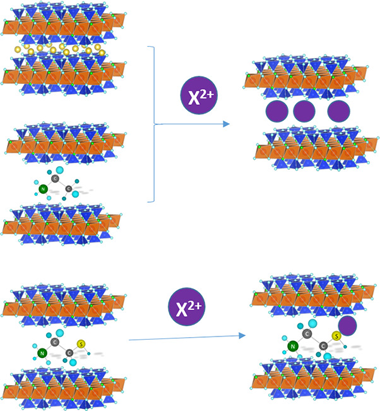
Abstract
The increasing accumulation of toxic heavy metals in the environment has generated the need of efficient removal systems, being the adsorption method the most popular one applied in aqueous solutions. Of particular concern is the case of Pb2+, Cd2+ and Hg2+ due to their high potential hazard. In this paper, we describe the feasibility of a new family of nanomaterials, swelling high charge micas, in the removal of these cations from aqueous solutions. Batch adsorption experiments were carried out in the as-made micas, NaMn, and after functionalization with ethylammonium, EA-Mn, and mercaptoethylammonium, MEA-Mn. The results have demonstrated that all of them are efficient heavy metal adsorbents, being Na-M2 the best adsorbent for Pb2+ and Cd2+, and, MEA-M2 for Hg2+.
April, 2021 · DOI: 10.1016/j.scitotenv.2020.142811
Materiales y Procesos Catalíticos de Interés Ambiental y Energético
LED-driven controlled deposition of Ni onto TiO2 for visible-light expanded conversion of carbon dioxide into C-1-C-2 alkanes
Sanz-Marco, A; Hueso, JL; Sebastian, V; Nielsen, D; Mossin, S; Holgado, JP; Bueno-Alejo, CJ; Balas, F; Santamaria, JNanoscale Advances DOI: 10.1039/d1na00021g

Abstract
Photocatalytic gas-phase hydrogenation of CO2 into alkanes was achieved over TiO2-supported Ni nanoparticles under LED irradiation at 365 nm, 460 nm and white light. The photocatalysts were prepared using photo-assisted deposition of Ni salts under LED irradiation at 365 nm onto TiO2 P25 nanoparticles in methanol as a hole scavenger. This procedure yielded 2 nm Ni particles decorating the surface of TiO2 with a nickel mass content of about 2%. Before the photocatalytic runs, Ni/TiO2 was submitted to thermal reduction at 400 °C in a 10% H2 atmosphere which induced O-defective TiO2−x substrates. The formation of oxygen vacancies, Ti3+ centers and metallic Ni sites upon photocatalytic CO2 hydrogenation was confirmed by operando EPR analysis. In situ XPS under reaction conditions suggested a strong metal–support interaction and the co-existence of zero and divalent Ni states. These photoactive species enhanced the photo-assisted reduction of CO2 below 300 °C to yield CO, CH4 and C2H6 as final products.
April, 2021 · DOI: 10.1039/d1na00021g
Nanotecnología en Superficies y Plasma
Electrochromic response and porous structure of WO3 cathode layers
Louloudakis, D; Mouratis, K; Gil-Rostra, J; Koudoumas, E; Alvarez, R; Palmero, A; Gonzalez-Elipe, ARElectrochimica Acta, 376 (2021) 138049 DOI: 10.1016/j.electacta.2021.138049
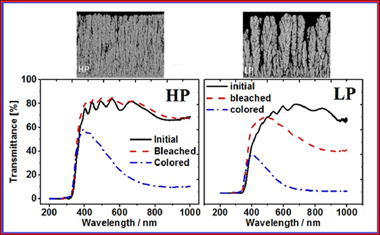
Abstract
Maximizing the electrochromic response of tungsten oxide-based systems demands highly porous electrode layers that facilitate the incorporation of electrolyte cations during the reduction process. In this work, amorphous and porous WO3 thin films were grown on indium tin dioxide glass substrates by magnetron sputtering at oblique angles at two different plasma gas pressures. Remarkably, the film that showed higher porosity presented a worse electrochromic response in terms of durability, time response and charge density capacity. This result is analyzed and explained on the basis of the features of the porous structure of the films: While the typical nanostructure developed at low pressures possesses large and connected pore voids with few ramifications, the nanostructure generated at a higher pressure presents a rather sponge-like porous structure with numerous and small well-connected voids. A general discussion on the role of the porous structure and, particularly, on the accessible pore volume and area is carried out. It is concluded that not only the accessible pore volume, defining the volume of electrolyte that stays inside the layer, but also the accessible pore area, which defines the efficiency of the incorporation/release of Li+ cations within the electrode material, determine the efficiency and reversibility of the electrochromic response.
April, 2021 · DOI: 10.1016/j.electacta.2021.138049
Química de Superficies y Catálisis
Cu supported Fe-SiO2 nanocomposites for reverse water gas shift reaction
Gonzalez-Castano, M; de Miguel, JCN; Sinha, F; Wabo, SG; Klepel, O; Arellano-Garcia, HJournal of CO2 Utilization, 46 (2021) 101493 DOI: 10.1016/j.jcou.2021.101493

Abstract
This work analyses the catalytic activity displayed by Cu/SiO2, Cu-Fe/SiO2 and Cu/FSN (Fe-SiO2 nanocomposite) catalysts for the Reverse Water Gas Shift reaction. Compared to Cu/SiO2 catalyst, the presence of Fe resulted on higher CO?s selectivity and boosted resistances against the constitution of the deactivation carbonaceous species. Regarding the catalytic performance however, the extent of improvement attained through incorporation Fe species strongly relied on the catalysts' configuration. At 30 L/gh and H-2:CO2 ratios = 3, the performance of the catalysts? series increased according to the sequence: Cu/SiO2 < Cu-Fe/SiO2 << Cu/FSN. The remarkable catalytic enhancements provided by Fe-SiO2 nanocomposites under different RWGS reaction atmospheres were associated to enhanced catalyst surface basicity's and stronger Cu-support interactions. The catalytic promotion achieved by Fe-SiO2 nanocomposites argue an optimistic prospective for nanocomposite catalysts within future CO2-valorising technologies.
April, 2021 · DOI: 10.1016/j.jcou.2021.101493
Materiales para Bioingeniería y Regeneración Tisular
Nanofibrous Matrix of Defined Composition Sustains Human Induced Pluripotent Stem Cell Culture
Borrego-Gonzalez, S; de la Cerda, B; Diaz-Corrales, FJ; Diaz-Cuenca, AACS Applied Bio Materials, 4 (2021) 3035-3040 DOI: 10.1021/acsabm.0c00425

Abstract
Human induced pluripotent stem cells (hiPSCs) represent the most promising biological material for regenerative medicine applications. In this work, a 3D solid nanofibrous matrix of defined composition (Colamigel-S) consisting of 97 wt % gelatin, 2.6 wt % atelocollagen, and 0.4 wt % laminin has been reproducibly processed and characterized and exhibits a homogeneous nanofibrillar network of high surface area, interconnected microcavities, and typical D-periodic collagen fibril nanostructural features. The purpose of the study was to test the performance of Colamigel-S as substrate for in vitro hiPSCs culture, finding that these cells efficiently attach and grow keeping their characteristic stem morphology and undifferentiated state.
April, 2021 · DOI: 10.1021/acsabm.0c00425
Química de Superficies y Catálisis
Fructose dehydration reaction over functionalized nanographitic catalysts in MIBK/H2O biphasic system
Martin, GD; Bounoukta, CE; Ammari, F; Dominguez, MI; Monzon, A; Ivanova, S; Centeno, MACatalysis Today, 366 (2021) 68-76 DOI: 10.1016/j.cattod.2020.03.016
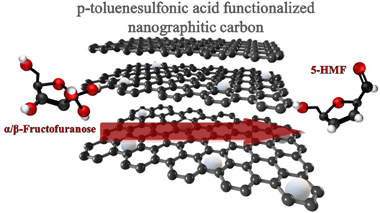
Abstract
A series of functionalized nanographitic carbons is prepared, characterized and tested in fructose dehydration reaction to 5-hydroxymethylfurfural. The functionalization treatment was selected to introduce various Bro?nsted acid sites and to modify the textural and catalytic properties of the initial carbon material. Within the series, the sulfonated carbons present the most interesting catalytic behavior resulting in important selectivity to the desired product once the reaction variables were properly adjusted.
April, 2021 · DOI: 10.1016/j.cattod.2020.03.016
Química de Superficies y Catálisis
Biogas Conversion to Syngas Using Advanced Ni-Promoted Pyrochlore Catalysts: Effect of the CH4/CO2 Ratio
le Sache, E; Moreno, AA; Reina, TRFrontiers in Chemistry, 9 (2021) 672419 DOI: 10.3389/fchem.2021.672419
Abstract
Biogas is defined as the mixture of CH4 and CO2 produced by the anaerobic digestion of biomass. This particular mixture can be transformed in high valuable intermediates such as syngas through a process known as dry reforming (DRM). The reaction involved is highly endothermic, and catalysts capable to endure carbon deposition and metal particle sintering are required. Ni-pyrochlore catalysts have shown outstanding results in the DRM. However, most reported data deals with CH4/CO2 stoichiometric ratios resulting is a very narrow picture of the overall biogas upgrading via DRM. Therefore, this study explores the performance of an optimized Ni-doped pyrochlore, and Ni-impregnated pyrochlore catalysts in the dry reforming of methane, under different CH4/CO2 ratios, in order to simulate various representatives waste biomass feedstocks. Long-term stability tests showed that the ratio CH4/CO2 in the feed gas stream has an important influence in the catalysts' deactivation. Ni doped pyrochlore catalyst, presents less deactivation than the Ni-impregnated pyrochlore. However, biogas mixtures with a CH4 content higher than 60%, lead to a stronger deactivation in both Ni-catalysts. These results were in agreement with the thermogravimetric analysis (TGA) of the post reacted samples that showed a very limited carbon formation when using biogas mixtures with CH4 content <60%, but CH4/CO2 ratios higher than 1.25 lead to an evident carbon deposition. TGA analysis of the post reacted Ni impregnated pyrochlore, showed the highest amount of carbon deposited, even with lower stoichiometric CH4/CO2 ratios. The later result indicates that stabilization of Ni in the pyrochlore structure is vital, in order to enhance the coke resistance of this type of catalysts.
April, 2021 · DOI: 10.3389/fchem.2021.672419
Nanotecnología en Superficies y Plasma
Form Birefringence in Resonant Transducers for the Selective Monitoring of VOCs under Ambient Conditions
Oliva-Ramirez, Manuel; Lopez-Santos, Carmen; Berthon, Hermine; Goven, Mathilde; Portoles, Jose; Gil-Rostra, Jorge; Gonzalez-Elipe, Agustin R.; Yubero, FranciscoACS Applied Materials & Interfaces, 13 (2021) 19148-19158 DOI: 10.1021/acsami.1c02499
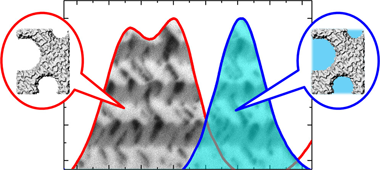
Abstract
In this work, we have developed a new kind of nanocolumnar birefringent Bragg microcavity (BBM) that, tailored by oblique angle deposition, behaves as a selective transducer of volatile organic compounds (VOCs). Unlike the atomic lattice origin of birefringence in anisotropic single crystals, in the BBM, it stems from an anisotropic self-organization at the nanoscale of the voids and structural elements of the layers. The optical adsorption isotherms recorded upon exposure of these nanostructured systems to water vapor and VOCs have revealed a rich yet unexplored phenomenology linked to their optical activity that provides both capacity for vapor identification and partial pressure determination. This photonic response has been reproduced with a theoretical model accounting for the evolution of the form birefringence of the individual layers upon vapor condensation in nanopores and internanocolumnar voids. BBMs that repel water vapor but are accessible to VOCs have been also developed through grafting of their internal surfaces with perfluorooctyltriethoxysilane molecules. These nanostructured photonic systems are proposed for the development of transducers that, operating under environmental conditions, may respond specifically to VOCs without any influence by the degree of humidity of the medium.
April, 2021 · DOI: 10.1021/acsami.1c02499
Reactividad de Sólidos
Enhancing the electrical conductivity of in-situ reduced graphene oxide-zirconia composites through the control of the processing routine
Lopez-Pernia, C; Morales-Rodriguez, A; Gallardo-Lopez, A; Poyato, RCeramics International, 47 (2021) 9382-9391 DOI: 10.1016/j.ceramint.2020.12.069
Abstract
Graphene oxide (GO) was mixed with 3 mol% yttria tetragonal zirconia polycrystal (3YTZP) using two powder processing routines: a colloidal method in an aqueous solution and a combination of ultrasonication with highenergy planetary ball milling in wet conditions. Highly densified 3YTZP composites with reduced GO (rGO) were consolidated by Spark Plasma Sintering. The in-situ reduction of GO was successfully achieved during the high temperature sintering process and a detailed study of the restoration of the graphene structure in the sintered composites has been made by Raman spectroscopy. Although no differences between the composites prepared by the two processing methods were found in the distribution of the rGO throughout the 3YTZP matrix for high rGO contents (i.e. the composites with 5 and 10 vol% rGO), a better distribution of the graphene phase was found in the composites with 1 and 2.5 vol% rGO prepared by planetary ball milling. This result, together with a better reduction of the GO in these composites, led to the obtaining of rGO/3YTZP composites with a better behavior in terms of electrical conductivity: an electrical percolation threshold below 2.5 vol% rGO and a high electrical conductivity value (-610 S/m for 10 vol% rGO).
April, 2021 · DOI: 10.1016/j.ceramint.2020.12.069
Materiales de Diseño para la Energía y Medioambiente
Organophilization of acid and thermal treated sepiolite for its application in BTEX adsorption from aqueous solutions
Varela, CF; Pazos, MC; Alba, MDJournal of Water Process Engineering, 40 (2021) 101949 DOI: 10.1016/j.jwpe.2021.101949
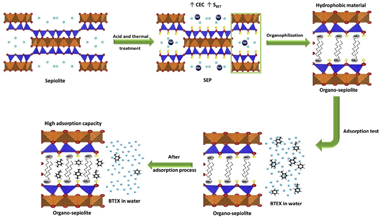
Abstract
Acid and thermal treated sepiolite was organophilized by cationic exchange with several alkylammonium cations (octylammonium, hexadecylammonium, tetradecyltrimethylammonium, and hexadecyltrimethylammonium). The adsorption capacity of BTEX from aqueous solutions was evaluated through the adsorption isotherms performed in batch. The results were analysed using three isotherm models: Freundlich, Langmuir and Dubinin-Radushkevich (D-R model). The behaviour of adsorption isotherm suggested the multilayer coverage on a heterogeneous surface, which is according to the Freundlich isotherm model. The thermodynamic analyse using the D-R model show that physical mechanisms govern the process. The maximum adsorption capacity of BTEX on the obtained materials was in the range values of 81.19 mg g(-1) - 1448.42 mg g(-)(1), which are higher than those reported up to now. The organo-sepiolite materials exhibit a high potential in the adsorption of BTEX compounds from aqueous solutions.
April, 2021 · DOI: 10.1016/j.jwpe.2021.101949
Nanotecnología en Superficies y Plasma
Rietveld Refinement, mu-Raman, X-ray Photoelectron, and Mossbauer Studies of Metal Oxide-Nanoparticles Growth on Multiwall Carbon Nanotubes and Graphene Oxide
Ramos-Guivar, JA; Gonzalez-Gonzalez, JC; Litterst, FJ; Passamani, ECCrystal Growth & Design, 21 (2021) 2128-2141 DOI: 10.1021/acs.cgd.0c01551
Abstract
Applying a modified coprecipitation method, maghemite and anatase nanoparticles embedded in graphene oxide and multiwall carbon nanotube frameworks were prepared, and a detailed structural characterization is presented. Transmission electron images have revealed that the multiwall carbon nanotubes and graphene oxide act as substrates to reduce the nanoparticle agglomeration with narrow sizes of ca. 9-20 nm, in agreement with the results of the Rietveld refinement, which have also indicated their crystallite apparent size and shapes using the spherical harmonics approach. In structural studies of maghemite nanoparticles by Raman spectroscopy, it was found that the effect of optical density and laser power intensity plays a significant role. When no optical filter was located between the powder sample and the laser source, a transformation from the gamma-Fe2O3 to the alpha-Fe2O3 phase was observed, as demonstrated by the disappearance of the characteristic broad Raman peak (A(1g)) of the gamma-Fe2O3 phase when increasing the laser power. X-ray photoelectron spectroscopy has also brought insights into the functionalization mechanism, suggesting that the one-pot reduction of the graphene oxide is favored by the alkaline gamma-Fe2O3 nanoparticle growth. The temperature dependence of the Fe-57 Mossbauer spectra has indicated that the effective anisotropy constant of Fe oxide-based nanoparticles is similar to that of bulk maghemite, and magnetic relaxation of Fe3+ spins depends on particle sizes.
April, 2021 · DOI: 10.1021/acs.cgd.0c01551
Nanotecnología en Superficies y Plasma
New Insights on the Conversion Reaction Mechanism in Metal Oxide Electrodes for Sodium-Ion Batteries
Mosa, J; Garcia-Garcia, FJ; Gonzalez-Elipe, AR; Aparicio, MNanomaterials, 11 (2021) 966 DOI: 10.3390/nano11040966
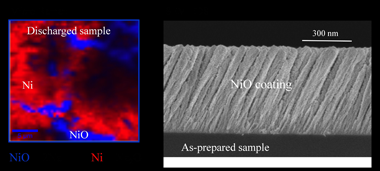
Abstract
Due to the abundance and low cost of exchanged metal, sodium-ion batteries have attracted increasing research attention for the massive energy storage associated with renewable energy sources. Nickel oxide (NiO) thin films have been prepared by magnetron sputtering (MS) deposition under an oblique angle configuration (OAD) and used as electrodes for Na-ion batteries. A systematic chemical, structural and electrochemical analysis of this electrode has been carried out. The electrochemical characterization by galvanostatic charge-discharge cycling and cyclic voltammetry has revealed a certain loss of performance after the initial cycling of the battery. The conversion reaction of NiO with sodium ions during the discharge process to generate sodium oxide and Ni metal has been confirmed by X-ray photoelectron spectra (XPS) and micro-Raman analysis. Likewise, it has been determined that the charging process is not totally reversible, causing a reduction in battery capacity.
April, 2021 · DOI: 10.3390/nano11040966
Nanotecnología en Superficies y Plasma
Novel procedure for studying laser-surface material interactions during scanning laser ablation cleaning processes on Cu-based alloys
Di Francia, E; Lahoz, R; Neff, D; Rico, V; Nuns, N; Angelini, E; Grassini, SApplied Surface Science, 544 (2021) art. 178820 DOI: 10.1016/j.apsusc.2020.148820

Abstract
Laser ablation is an effective method to clean Cu-based alloys. A novel procedure of characterisation was developed involving O-18 isotopes evaluated by ToF-SIMS spectroscopy to assess the driving mechanisms of laser-surface interactions. The presence of re-oxidised compounds was detected, discerning between the oxygen from the corrosion layer and the one introduced by the interaction with the laser (that was generated in a controlled atmosphere of O-18 diluted in N-2). A set of samples treated with different laser conditions were characterised by FESEM and mu Raman. The results have shown that re-oxidation phenomenon can occur and its selectivity depends on the laser conditions.
April, 2021 · DOI: 10.1016/j.apsusc.2020.148820
Nanotecnología en Superficies y Plasma
Solid-State Dewetting of Gold on Stochastically Periodic SiO2 Nanocolumns Prepared by Oblique Angle Deposition
Oliva-Ramirez, M; Wang, D; Flock, D; Rico, V; Gonzalez-Elipe, AR; Schaaf, PACS Applied Materials & Interfaces, 13 (2021) 11385-11395 DOI: 10.1021/acsami.0c19327
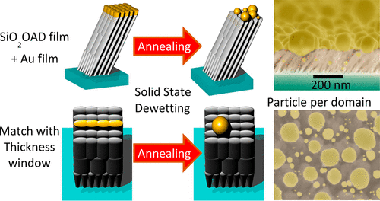
Abstract
Solid-state dewetting (SSD) on patterned substrates is a straightforward method for fabricating ordered arrays of metallic nanoparticles on surfaces. However, a drawback of this procedure is that the patterning of substrates usually requires time-consuming and expensive two-dimensional (2D) fabrication methods. Nanostructured thin films deposited by oblique angle deposition (OAD) present at the surface a form of stochastically arranged periodic bundles of nanocolumns that might act as a patterned template for fabricating arrays of nanoparticles by SSD. In this work, we explore this concept and investigate the effect of three different types of OAD SiO2 thin films on the SSD of Au deposited on their surface. We demonstrate that the size and spatial distribution of the particles can be tailored through the surface morphology of these OAD film substrates. It has been found that the SSD of the evaporated Au layer gives rise to a bimodal size distribution of particles. A majority of them appeared as mesoparticles with sizes.100 nm and the rest as nanoparticles with similar to 10 nm, respectively, located either on top of the nanocolumns following their lateral distribution (i.e., resulting from a patterning effect) or incorporated inside the open mesopores existing among them. Moreover, on the SiO2-OAD thin films where interconnected nanocolumnar bundles arrange in the form of discrete motifs, the patterning effect gave rise to the formation of approximately one Au mesoparticle per motif, which is one of the assets of patterned SSD. The morphological, optical (i.e., plasmon resonance), and crystalline structural characteristics of Au mesoparticles suggest that the interplay between a discontinuous nanocolumnar surface acting as a template and the poor adhesion of Au onto SiO2 are key factors for the observed template effect controlling the SSD on the surface of OAD thin films.
March, 2021 · DOI: 10.1021/acsami.0c19327
Materiales de Diseño para la Energía y Medioambiente
Zirconium retention for minimizing environmental risk: Role of counterion and clay mineral
Montes, L; Pavon, E; Cota, A; AlbaChemosphere, 267 (2021) 128914 DOI: 10.1016/j.chemosphere.2020.128914
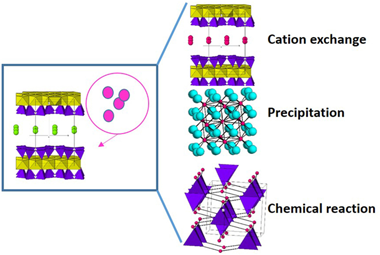
Abstract
Zr(IV) together with U(IV) are the major components of high-level radionuclide waste (HLRW) and spent nuclear fuel (SNF) from nuclear power plants. Thus, their retention in the waste disposal is of great importance for the environmental risk control. Here, the influence of clay minerals on the retention of Zr(IV), as component of the nuclear waste and as chemical analogues of U(IV), has been evaluated. Three clay minerals, two bentonites and one saponite, were hydrothermally treated with three zirconium salts. A structural study at long-range order by X-ray diffraction and short-range order by NMR was performed to evaluate the generation of new zirconium phases and degradation of the clay minerals. Three immobilization mechanisms were observed: i) cation exchange of ZrO2+ or Zr4+ by clay minerals, ii) the precipitation/crystallization of ZrO2, and, iii) the chemical interaction of zirconium with the clay minerals, with the formation of zirconium silicates.
March, 2021 · DOI: 10.1016/j.chemosphere.2020.128914
Materiales y Procesos Catalíticos de Interés Ambiental y Energético
Overcoming Pd-TiO2 Deactivation during H-2 Production from Photoreforming Using Cu@Pd Nanoparticles Supported on TiO2
Platero, F; Lopez-Martin, A; Caballero, A; Rojas, TC; Nolan, M; Colon, GACS Applied Nano Materials, 4 (2021) 3204-3219 DOI: 10.1021/acsanm.1c00345
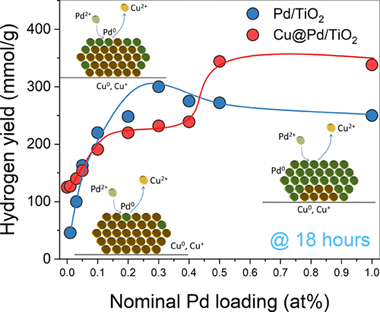
Abstract
Different Cu@Pd-TiO2 systems have been prepared by a two-step synthesis to obtain a bimetallic co-catalyst for the H-2 photoreforming reaction. We find that the tailored deposition of Pd covering the Cu nanoclusters by a galvanic replacement process results in the formation of a core@shell structure. The photocatalytic H-2 production after 18 h is 350 mmol/g on the Cu@Pd-1.0-TiO2 bimetallic system, which is higher than that on the monometallic ones with a H-2 production of 250 mmol/g on Pd-supported TiO2. Surface characterization by highangle annular dark-field scanning transmission electron microscopy, H-2-temperatureprogramed reduction, CO-FTIR spectroscopy, and XPS gives clear evidence of the formation of a core@shell structure. With a Pd loading of 0.2-0.3 at. %, we propose a full coverage of the Cu nanoparticles with Pd. Long-time photoreforming runs show the enhanced performance of supported Cu@Pd with respect to bare palladium leading to a more stable catalyst and ultimately higher H-2 production.
March, 2021 · DOI: 10.1021/acsanm.1c00345
Reactividad de Sólidos
A first insight into the microstructure and crack propagation in novel boron nitride nanosheet/3YTZP composites
Munoz-Ferreiro, C; Morales-Rodriguez, A; Gallardo-Lopez, A; Poyato, RBoletin de la Sociedad Española de Cerámica y Vidrio, 60 (2021) 128-136 DOI: 10.1016/j.bsecv.2020.02.003
Abstract
In this work, novel 3 mol% yttria tetragonal zirconia polycristalline (3YTZP) ceramic composites with boron nitride nanosheets (BNNS) are investigated for the first time. Highly densified composites with 1 and 4 vol% BNNS were obtained by spark plasma sintering (SPS) after BNNS synthesis using a solution exfoliation method and BNNS dispersion into the ceramic powder by ultrasonication. The BNNS presented homogeneous distribution throughout the ceramic matrix and preferential alignment in the plane perpendicular to the pressing axis during SPS. The BNNS incorporation had practically no effect on the Vickers hardness of the material nor on the Young's modulus. Anisotropy in crack development was found in the composite with 4% vol BNNS, together with a mechanism of extensive microcracking. Several energy-absorbing mechanisms during crack propagation, such as crack deflection, crack bridging, crack branching, BNNS pull-out and BNNS debonding, were identified in the composites by a close observation of the indentation-induced fracture paths.
March, 2021 · DOI: 10.1016/j.bsecv.2020.02.003
Reactividad de Sólidos
EGFR-targeting antitumor therapy: Neuregulins or antibodies?
de Lavera, I; Merkling, PJ; Oliva, JM; Sayagues, MJ; Cotan, D; Sanchez-Alcazar, JA; Infante, JJ; Zaderenko, A.P.European Journal of Pharmaceutical Sciences, 158 (2021) 105678 DOI: 10.1016/j.ejps.2020.105678
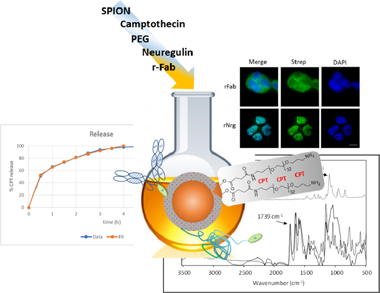
Abstract
Malignancies such as lung, breast and pancreatic carcinomas are associated with increased expression of the epidermal growth factor receptor, EGFR, and its role in the pathogenesis and progression of tumors has made this receptor a prime target in the development of antitumor therapies. In therapies targeting EGFR, the development of resistance owing to mutations and single nucleotide polymorphisms, and the expression of the receptor ligands themselves are very serious issues. In this work, both the ligand neuregulin and a bispecific antibody fragment to EGFR are conjugated separately or together to the same drug-delivery system to find the most promising candidate. Camptothecin is used as a model chemotherapeutic drug and superparamagnetic iron oxide nanoparticles as a delivery system. Results show that the lowest LD50 is achieved by formulations conjugated to both the antibody and the ligand, demonstrating a synergy. Additionally, the ligand location in the nucleus favors the antitumor activity of Camptothecin. The high loading capacity and efficiency convert these systems into a good alternative for administering Camptothecin, a drug whose use is otherwise severely limited by its chemical instability and poor solubility. Our choice of targeting agents allows treating tumors that express ErbB2 (Her2+ tumors) as well as Her2- tumors expressing EGFR.
March, 2021 · DOI: 10.1016/j.ejps.2020.105678
Propiedades mecánicas, modelización y caracterización de cerámicos avanzados
Cation-driven electrical conductivity in Ta-doped orthorhombic zirconia ceramics
Moshtaghioun, BM; Laguna-Bercero, MA; Pena, JI; Gomez-Garcia, D; Dominguez-Rodriguez, ACeramics International, 47 (2021) 7248-7522 DOI: 10.1016/j.ceramint.2020.10.227
Abstract
This paper is devoted to the study of the electrical conductivity of tantalum-doped zirconia ceramics prepared by spark plasma sintering. In this study, the temperature dependence of conductivity in as-prepared specimens and in those previously annealed in air is determined and compared. A semi-empirical model, which is based on the oxidation states of the cations, has been developed and successfully assessed. According to this, the conductivity is basically controlled by the diffusion of tetravalent zirconium cations in both cases, although the concentration of these species varies drastically with the amount of induced oxygen vacancies. This is a quite unexpected fact, since conductivity is normally controlled by anionic diffusion in zirconia ceramics. This option is forbidden here due to the presence of substitutional pentavalent cations. Therefore, conductivity values are much lower than those reported in trivalent or divalent substitutional cation doped zirconia ceramics.
March, 2021 · DOI: 10.1016/j.ceramint.2020.10.227
Materiales para Bioingeniería y Regeneración Tisular
Nanofibrous Gelatin-Based Biomaterial with Improved Biomimicry Using D-Periodic Self-Assembled Atelocollagen
Borrego-Gonzalez, S; Dalby, MJ; Diaz-Cuenca, ABiomimetics, 6 (2001) 20 DOI: 10.3390/biomimetics6010020
Abstract
Design of bioinspired materials that mimic the extracellular matrix (ECM) at the nanoscale is a challenge in tissue engineering. While nanofibrillar gelatin materials mimic chemical composition and nano-architecture of natural ECM collagen components, it lacks the characteristic D-staggered array (D-periodicity) of 67 nm, which is an important cue in terms of cell recognition and adhesion properties. In this study, a nanofibrous gelatin matrix with improved biomimicry is achieved using a formulation including a minimal content of D-periodic self-assembled atelocollagen. We suggest a processing route approach consisting of the thermally induced phase separation of the gelatin based biopolymeric mixture precursor followed by chemical-free material cross-linking. The matrix nanostructure is characterized using field emission gun scanning electron microscopy (FEG-SEM), transmission electron microscopy (TEM), wide angle X-ray diffraction (XRD) and Fourier-transform infrared spectroscopy (FT-IR). The cell culture assays indicate that incorporation of 2.6 wt.% content of D-periodic atelocollagen to the gelatin material, produces a significant increase of MC3T3-E1 mouse preosteoblast cells attachment and human mesenchymal stem cells (hMSCs) proliferation, in comparison with related bare gelatin matrices. The presented results demonstrate the achievement of an efficient route to produce a cost-effective, compositionally defined and low immunogenic “collagen-like” instructive biomaterial, based on gelatin.
March, 2021 · DOI: 10.3390/biomimetics6010020
Nanotecnología en Superficies y Plasma
Electrical and reaction performances of packed-bed plasma reactors moderated with ferroelectric or dielectric materials
Gomez-Ramirez, A; Alvarez, R; Navascues, P; Garcia-Garcia, FJ; Palmero, A; Cotrino, J; Gonzalez-Elipe, ARPlasma Processes and Polymers, (2021) e2000193 DOI: 10.1002/ppap.202000193
Abstract
The operational behavior of packed-bed plasma reactors depends on the dimension, shape, and chemical properties of the pellets used as moderators, but little information exists about the influence of their specific dielectric properties. Herein, we comparatively study the electrical behavior of a packed-bed reactor filled with pellets of either dielectric (Al2O3 and glass) or ferroelectric (BaTiO3 and lead zirconate titanate) materials. We found that plasma current was higher for ferroelectrics and presented a nonlineal dependence on voltage. Moreover, for BaTiO3, we found a drastic decrease at around its relatively low Curie temperature. Differences in electrical behavior have a direct effect on the reactor performance, as illustrated for the ammonia synthesis, demonstrating the importance of moderator material dielectric properties and their dependence on temperature.
March, 2021 · DOI: 10.1002/ppap.202000193
Química de Superficies y Catálisis
Synergizing carbon capture and utilization in a biogas upgrading plant based on calcium chloride: Scaling-up and profitability analysis
Baena-Moreno, FM; Reina, TR; Rodriguez-Galan, M; Navarrete, B; Vilches, LFScience of The Total Environment, 758 (2021) 143645 DOI: 10.1016/j.scitotenv.2020.143645
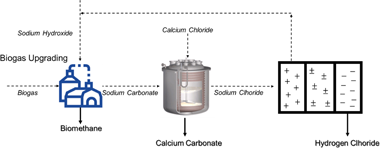
Abstract
Herein we analyze the profitability of a novel regenerative process to synergize biogas upgrading and carbon dioxide utilization. Our proposal is a promising alternative which allows to obtain calcium carbonate as added value product while going beyond traditional biogas upgrading methods with high thermal energy consumption. Recently we have demonstrated the experimental viability of this route. In this work, both the scale-up and the profitability of the process are presented. Furthermore, we analyze three representative scenarios to undertake a techno-economic study of the proposed circular economy process. The scale-up results demonstrate the technical viability of our proposal. The precipitation efficiency and the product quality are still remarkable with the increase of the reactor size. The techno-economic analysis reveals that the implementation of this circular economy strategy is unprofitable without subsidies. Nonetheless, the results are somehow encouraging as the subsides needed to reach profitability are lower than in other biogas upgrading and carbon dioxide utilization proposals. Indeed, for the best-case scenario, a feed-in tariff incentive of 4.3 (sic)/MWh makes the approach profitable. A sensitivity study through tornado analysis is also presented, revealing the importance of reducing bipolar membrane electrodialysis energy consumption. Overall our study envisages the big challenge that the EU faces during the forthcoming years. The evolution towards bio-based and circular economies requires the availability of economic resources and progress on engineering technologies.
March, 2021 · DOI: 10.1016/j.scitotenv.2020.143645
Materiales Avanzados
Mining Wastes of an Albite Deposit as Raw Materials for Vitrified Mullite Ceramics
Sanchez-Soto, PJ; Garzon, E; Perez-Villarejo, L; Angelopoulos, GN; Eliche-Quesada, DMinerals, 11 (2021) 232 DOI: 10.3390/min11030232
Abstract
In this work, an examination of mining wastes of an albite deposit in south Spain was carried out using X-ray Fluorescence (XRF), X-ray diffraction (XRD), particle size analysis, thermodilatometry and Differential Thermal Analysis (DTA) and Thermogravimetric (TG) analysis, followed by the determination of the main ceramic properties. The albite content in two selected samples was high (65-40 wt. %), accompanied by quartz (25-40 wt. %) and other minor minerals identified by XRD, mainly kaolinite, in agreement with the high content of silica and alumina determined by XRF. The content of Na2O was in the range 5.44-3.09 wt. %, being associated with albite. The iron content was very low (<0.75 wt. %). The kaolinite content in the waste was estimated from similar to 8 to 32 wt. %. The particle size analysis indicated values of 11-31 wt. % of particles <63 mu m. The ceramic properties of fired samples (1000-1350 degrees C) showed progressive shrinkage by the thermal effect, with water absorption and open porosity almost at zero at 1200-1250 degrees C. At 1200 ffiC, the bulk density reached a maximum value of 2.38 g/cm(3). An abrupt change in the phase evolution by XRD was found from 1150 to 1200 degrees C, with the disappearance of albite by melting in accordance with the predictions of the phase diagram SiO2-Al2O3-Na2O and the system albite-quartz. These fired materials contained as main crystalline phases quartz and mullite. Quartz was present in the raw samples and mullite was formed by decomposition of kaolinite. The observation of mullite forming needle-shape crystals was revealed by Scanning Electron Microscopy (SEM). The formation of fully densified and vitrified mullite materials by firing treatments was demonstrated.
March, 2021 · DOI: 10.3390/min11030232
Química de Superficies y Catálisis
Zr and Fe on Pt/CeO2-MOx/Al2O3 catalysts for WGS reaction
Gonzalez-Castano, M; Ivanova, S; Centeno, MA; Ioanides, T; Arellano-Garcia, H; Odriozola, JAInternational Journal of Hydrogen Energy, (2021) DOI: 10.1002/er.6646
Abstract
By evaluating the functional modifications induced by Zr and Fe as dopants in Pt/CeO2‐MOx/Al2O3 catalysts (M = Fe and Zr), the key features for improving water gas shift (WGS) performance for these systems have been addressed. Pt/ceria intrinsic WGS activity is often related to improved H2 surface dynamics, H2O absorption, retentions and dissociation capacities which are influenced greatly by the support nature. Two metals, iron and zirconia, were chosen as ceria dopants in this work, either in separate manner or combined. Iron incorporation resulted in CO‐redox properties and oxygen storage capacities (OSC) improvement but the formation of Ce‐Fe solid solutions did not offer any catalytic benefit, while the Zr incorporation influenced in a great manner surface electron densities and shows higher catalytic activity. When combined both metals showed an important synergy evidenced by 30% higher CO conversions and attributed to greater surface electron densities population and therefore absorption and activity. This work demonstrates that for Pt/ceria catalysts OSC enhancement does not necessarily imply a catalytic promotion.
March, 2021 · DOI: 10.1002/er.6646
Fotocatálisis Heterogénea: Aplicaciones
Facile synthesis and characterization of a novel 1,2,4,5-benzene tetracarboxylic acid doped polyaniline@zinc phosphate nanocomposite for highly efficient removal of hazardous hexavalent chromium ions from water
Abdelghani Hsini, Yassine Naciri, Mohamed Benafqir, Zeeshan Ajmal, Nouh Aarab, Mohamed Laabd, J.A. Navío, F. Puga, Rabah Boukherroub, Bahcine Bakiz, Abdallah AlbourineJournal of Colloid and Interface Science, 585 (2021) 560-573 DOI: 10.1016/j.jcis.2020.10.036
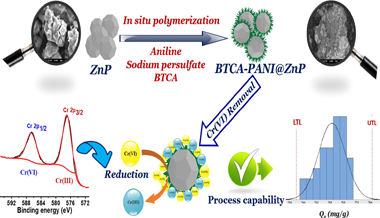
Abstract
The present study describes the preparation of a novel 1,2,4,5-benzene tetracarboxylic acid doped polyaniline@zinc phosphate (BTCA-PANI@ZnP) nanocomposite via a facile two-step procedure. Thereafter, the as-prepared composite material adsorption characteristics for Cr(VI) ions removal were evaluated under batch adsorption. Kinetic approach studies for Cr(VI) removal, clearly demonstrated that the results of the adsorption process followed the pseudo second order and Langmuir models. The thermodynamic study indicated a spontaneous and endothermic process. Furthermore, higher monolayer adsorption was determined to be 933.88 mg g1 . In addition, the capability study regarding Cr(VI) ions adsorption over BTCA-PANI@ZnP nanocomposite clearly revealed that our method is suitable for large scale application. X-ray photoelectron spectroscopy (XPS) analysis confirmed Cr(VI) adsorption on the BTCA-PANI@ZnP surface, followed by its subsequent reduction to Cr(III). Thus, the occurrence of external mass transfer, electrostatic attraction and reduction phenomenon were considered as main mechanistic pathways of Cr(VI) ions removal. The superior adsorption performance of the material, the multidimensional characteristics of the surface and the involvement of multiple removal mechanisms clearly demonstrated the potential applicability of the BTCA-PANI@ZnP material as an effective alternative for the removal of Cr(VI) ions from wastewater.
March, 2021 · DOI: 10.1016/j.jcis.2020.10.036
Materiales Ópticos Multifuncionales
The Complex Interplay of Lead Halide Perovskites with Their Surroundings
Galisteo-Lopez, JF; Calvo, ME; Miguez, HAdvanced Optical Materials, (2021) 2100133 DOI: 10.1002/adom.202100133
Abstract
Photoexcitation of lead halide perovskites induces a restructuration of the material that simultaneously enhances its emission properties and triggers its degradation. These concomitant processes are strongly dependent on the surroundings of the perovskite, both while and after being processed, underlining the relevance the environment and the interfacial design have in the stability and performance of these materials and the devices based on them. This shocking observation reveals that when subjected to external illumination, lead halide perovskites undergo a number of photophysical processes that strongly modify their structure and thus their optoelectronic properties. Such photoinduced instability stems from a defective structure directly linked to the low-temperature and solution-processed fabrication routes generally employed to build perovskite solar cells with efficiencies comparable to state-of-the-art values. On the other hand, these same inexpensive and unsophisticated procedures make this material a promising component in energy conversion devices. Here, an analysis is provided regarding the different impact on the perovskite structure, hence on its optoelectronic performance, that the interaction with its surroundings has, providing specific examples that highlight this interplay, describing the kind of modification it induces, and listing the related effects on the optoelectronic properties that should be accounted for when characterizing them.
March, 2021 · DOI: 10.1002/adom.202100133
Materiales Ópticos Multifuncionales - Materiales Coloidales
Persistent luminescence of transparent ZnGa2O4:Cr3+ thin films from colloidal nanoparticles of tunable size
Arroyo, E; Medran, B; Castaing, V; Lozano, G; Ocana, M; Becerro, AIJournal of Materials Chemistry C, 9 (2021) 4474-4485 DOI: 10.1039/d1tc00258a
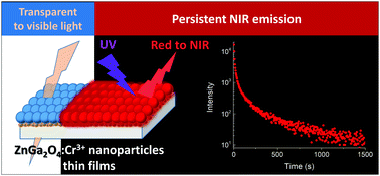
Abstract
We report on the fabrication of ZnGa2O4:Cr3+ transparent thin films and the evaluation, for the first time in the literature, of their persistent red to NIR emission. For this purpose, we have used a simple and economic global strategy based on wet processing methods from colloidal nanospheres with uniform size. A microwave-assisted hydrothermal method was first developed for the synthesis of precursor particles, which allows size tuning from 300 nm to 30 nm through simple modification of the Zn2+ precursor and the Cr3+ content of the starting solutions. ZnGa2O4:Cr3+ transparent thin films over quartz substrates were then easily fabricated by spin coating, and their structural and optical characteristics were analyzed in detail after annealing at high temperature to elucidate the effect of processing temperature and particle size on the properties of the films. Indeed, our results indicate that high temperature annealing does not compromise the transparency of the films but improves their photoluminescence. In addition, the analysis reveals that persistence luminescence in our films is rather independent of the size of the precursor nanoparticles. Due to their transparency and persistent emission properties, films fabricated from colloidal suspensions of ZnGa2O4:Cr3+ nanoparticles show great potential for application in the fields of chemical sensing, information storage, labelling, and anti-counterfeiting technology.
March, 2021 · DOI: 10.1039/d1tc00258a
Química de Superficies y Catálisis
Functionalized biochars as supports for Pd/C catalysts for efficient hydrogen production from formic acid
Santos, JL; Megias-Sayago, C; Ivanova, S; Centeno, MA; Odriozola, JAApplied Catalysis B-Environmental, 282 (2021) 119615 DOI: 10.1016/j.apcatb.2020.119615
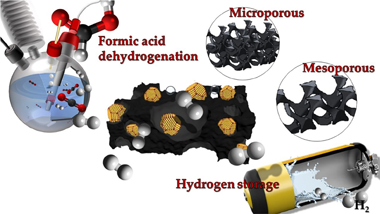
Abstract
Biomass waste product was used to generate biochars as catalytic supports for selective hydrogen production from formic acid. The supports were obtained after pyrolysis in CO2 atmosphere of non-pretreated and che-mically ZnCl2 activated raw materials (vine shoot and crystalline cellulose). The support series includes materials with different textural properties and surface chemistry. The support nature and especially textural properties firstly affects significantly Pd size and dispersion and its interaction with the support and secondly influence in a great extent the catalytic behavior of the final material. The presence of prevailing mesoporous character appeared to be the most important parameter influencing formic acid dehydrogenation and overall hydrogen production.
March, 2021 · DOI: 10.1016/j.apcatb.2020.119615
Tribología y Protección de Superficies
Long-term low friction maintenance and wear reduction on the ventral scales in snakes
Sanchez-Lopez, JC; Schaber, CF; Gorb, SNMaterials Letters, 285 (2021) 129011 DOI: 10.1016/j.matlet.2020.129011
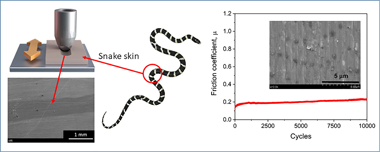
Abstract
Snake skins evolved to withstand permanent friction and wear during sliding. Here, the microstructure of ventral scales of the snake Lampropeltis getula californiae was analyzed using scanning electron microscopy, and the long-term dynamic friction behavior was investigated by reciprocating sliding friction tests. A smooth epoxy resin with similar elasticity modulus and hardness was used for comparison purposes. Strong differences in frictional and wear mechanisms between the two materials were revealed in spite of similar mechanical properties. Snake skin showed a considerably lower frictional coefficient that kept stable over several thousands of sliding cycles. A reduction of the stick-slip behavior was also denoted by analyzing the variation of the friction coefficient in the forward and reverse motion influencing the wear mechanism. This frictional behavior can be explained by three different but complementary mechanisms: fibrous layered composite material of the skin with a gradient of material properties, surface microstructure, and the presence of ordered layers of lipid molecules at the skin surface.
February, 2021 · DOI: 10.1016/j.matlet.2020.129011
Materiales Ópticos Multifuncionales
Impact of Tb4+ and morphology on the thermal evolution of Tb-doped TiO2 nanostructured hollow spheres and nanoparticles
Colomer, MT; Rodriguez, E; Moran-Pedroso, M; Vattier, F; de Andres, AJournal of Alloys and Compounds, 853 (2021) 156973 DOI: 10.1016/j.jallcom.2020.156973
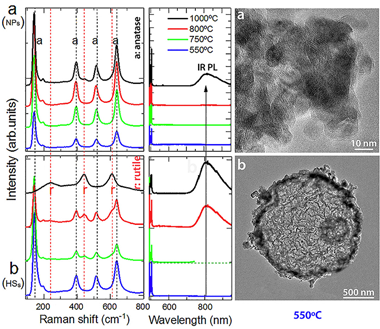
Abstract
Tb-doped TiO2 hollow spheres (HSs) in the range 0.0-2.0 at.% have been synthesized by the first time to the best of our knowledge. The HSs are compared with nanoparticles (NPs) to evaluate the impact of morphology on their physicochemical and photoluminescence (PL) behavior upon increasing calcination temperature. After calcination at 550 degrees C, the particles are anatase with a primary average size of 10.0 +/- 0.2 nm for the NPs and 12.0 +/- 0.2 nm for those that form the micron sized hollow spheres of 1.8 +/- 0.2 mu m diameter and ca. 64 nm shell thickness. The temperature of the anataseerutile transition is found to be strongly dependent on the presence of Tb as well as on morphology. Contrarily to the usual stabilization of anatase when doping with trivalent rare-earth ions, the transition temperature is reduced when doping with Tb. The rutile phase is further favored for the HSs compared to the NPs probably related to the low density of the HSs and/or a more efficient packing density and/or a bigger crystal size of the nanoparticles that form those spheres with respect to the packing and the size of the NPs and/or the crystal size of the nanoparticles of the HSs with respect to the size of the NPs. Only a slight unit-cell volume increase for the anatase structure is observed upon Tb doping, in both the NPs and in the HSs, contrary to the expected increment due to the larger ionic radius of Tb3+ compared to Ti4+. In addition, the intensity of the characteristic f-f Tb3+ emission bands is extremely weak both in the anatase and rutile phases. The transition is accompanied with the emergence of an infrared emission band centered at 810 nm related to the formation of defects during the structural transformation providing deep levels in the gap that partly quench the f-f emissions in the rutile phase. The results are consistent with the presence of Tb in both +3 and +4 valence states. XPS measurements confirmed the presence of Tb3+ as well as of Tb4+ in both HSs and NPs. The large fraction of Tb4+ present in the samples originates the weak f-f emission intensity, an only slight increase of the cell parameters and the destabilization of the anatase phase.
February, 2021 · DOI: 10.1016/j.jallcom.2020.156973
Tribología y Protección de Superficies
Insights into the role of the layer architecture of Cr-Ti-N based coatings in long-term high temperature oxidation experiments in steam atmosphere
Mato, S; Sanchez-Lopez, JC; Barriga, J; Perez, FJ; Alcala, GCeramics International, 47 (2021) 4257-4266 DOI: 10.1016/j.ceramint.2020.10.003
Abstract
Knowledge on hard coatings has been applied in the energy field extending their use as protecting coatings of steam power generation plants components. The role of the layer architecture of Cr-Ti-N based coatings deposited by reactive cathodic arc evaporation on P92 steel substrates was studied with the focus on their oxidation resistance at 650 degrees C in 100% steam atmosphere up to 2000 h. Characterization of the coatings was performed by gravimetry, scanning electron microscopy, electron probe microanalysis, glow discharge optical emission spectroscopy, X-ray diffraction, thermodynamic simulations using the CALPHAD method, Rockwell C indentation and nanoindentation. The layered arrangement improves the oxidation resistance of TiN under the working conditions of steam power plants, as well as the mechanical properties of CrN. The produced architectures performance under the described working conditions boosts the understanding of the processes taking place at high temperature, making possible the design of optimal coatings combining the best behavior of both nitrides for each specific application, reaching a corrosion protection at high temperature in water vapor comparable to that of CrN and a hardness and Young's modulus as high as those of TiN.
February, 2021 · DOI: 10.1016/j.ceramint.2020.10.003
Nanotecnología en Superficies y Plasma
Active sites and optimization of mixed copper-cobalt oxide anodes for anion exchange membrane water electrolysis
Lopez-Fernandez, E; Gil-Rostra, J; Escudero, C; Villar-Garcia, IJ; Yubero, F; Consuegra, AD; Gonzalez-Elipe, ARJournal of Power Sources, 485 (2021) 229217 DOI: 10.1016/j.jpowsour.2020.229217
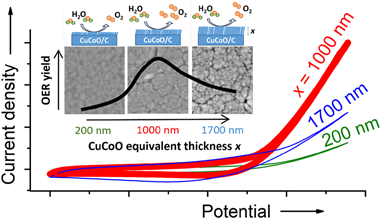
Abstract
The optimization of the catalysts incorporated to the electrodes for anion exchange membrane water electmlysers is a key issue to maximize their performance through the improvement of the oxygen evolution reaction (OER) yield. In this work, we show that the modification of the microstructure and the chemical properties of a mixed copper-cobalt oxide anode may contribute to increase the activity of this reaction. For this purpose, the OER has been systematically studied, either in a half cell or in a membrane electrode assembly configuration, as a function of the load and agglomeration degree of the catalysts used as electrodes, as prepared on a carbon paper support by magnetron sputtering deposition in an oblique angle configuration. Chemical analysis by X-ray absorption spectroscopy and electrochemical analysis by cyclic voltammetry and impedance spectroscopy have shown that cobalt-copper mixed oxide catalysts with a 1.8 Co/Cu atomic ratio and about one micron equivalent thickness maximizes the cell performance. The chemical, structural and microstructural factors controlling the final behaviour of these anodes and accounting for this maximization of the reaction yield are discussed on the basis of these characterization results and as a function of preparation variables of the electrodes and operating conditions of the cell.
February, 2021 · DOI: 10.1016/j.jpowsour.2020.229217
Propiedades mecánicas, modelización y caracterización de cerámicos avanzados
The Possible Detriment of Oxygen in Creep of Alumina and Zirconia Ceramic Composites Reinforced with Graphene
Cano-Crespo, R; Rivero-Antunez, P; Gomez-Garcia, D; Moreno, R; Dominguez-Rodriguez, AMaterials, 14 (2021) 984 DOI: 10.3390/ma14040984
Abstract
This paper aims to give an answer to the following question: is the oxidation of graphene a critical issue for high-temperature plasticity in graphene-reinforced ceramics? To give a convincing reply, we will focus on two very different graphene-based ceramic composites: reduced graphene oxide (rGO)-reinforced alumina (alpha-Al2O3) and reduced graphene oxide (rGO)-reinforced yttria tetragonal zirconia (t-ZrO2). The processing of the powders has been made using a colloidal route, and after that, a spark plasma sintering process was performed in order to densify the samples. Creep tests were performed at temperatures between 1200-1250 degrees C in an argon atmosphere. The microstructure obtained by SEM of the sintered and tested specimens was characterized quantitatively to elucidate the deformation mechanism. Raman spectroscopy was carried out to check the integrity of the graphene. The average grain size was in the order of 1 mu m and the shape factor was 0.7 for all the studied materials. The integrity of the graphene was checked before and after the creep experiments. The careful analysis of the creep tests shows that graphene oxide or its reduced version are not efficient phases for creep resistance improvement in general, contrary to what is reported elsewhere. However, the results permit the suggestion of a creep improvement in nanocomposites at a very high temperature regime due to an enhanced reactivity of oxygen between carbon and alumina interfaces. In the case of zirconia, the results give us the conclusion that the oxidation of graphene is a highly detrimental issue regarding the improvement of high-temperature plasticity.
February, 2021 · DOI: 10.3390/ma14040984
Reactividad de Sólidos
A Novel, Simple and Highly Efficient Route to Obtain PrBaMn2O5+δ Double Perovskite: Mechanochemical Synthesis
Garcia-Garcia, FJ; Sayagues, MJ; Gotor, FJNanomaterials, 11 (2021) 380 DOI: 10.3390/nano11020380
Abstract
In this work, a mechanochemical route was proposed for the synthesis of the PrBaMn2O5+δ (PMBO) double layered perovskite phase. The mechanochemical reaction between Pr6O11, BaO2, and MnO powders with cationic stoichiometric ratios of 1/1/2 for Pr/Ba/Mn was performed using high-energy milling conditions in air. After 150 min of milling, a new phase with perovskite structure and cubic symmetry consistent with the A-site disordered Pr0.5Ba0.5MnO3 phase was formed. When this new phase was subsequently annealed at a high temperature in an inert Ar atmosphere, the layered PrBaMn2O5+δ phase was obtained without needing to use a reducing atmosphere. At 1100 °C, the fully reduced layered PrBaMn2O5 phase was achieved. A weight gain was observed in the 200–300 °C temperature range when this fully reduced phase was annealed in air, which was consistent with the transformation into the fully oxidized PrBaMn2O6 phase. The microstructural characterization by SEM, TEM, and HRTEM ascertained the formation of the intended PrBaMn2O5+δ phase. Electrical characterization shows very high electrical conductivity of layered PBMO in a reducing atmosphere and suitable in an oxidizing atmosphere, becoming, therefore, excellent candidates as solid oxide fuel cell (SOFC electrodes).
February, 2021 · DOI: 10.3390/nano11020380
Fotocatálisis Heterogénea: Aplicaciones
Enhanced UV and visible light photocatalytic properties of synthesized AgBr/SnO2 composites
Puga, F.; Navío, J.A.; Hidalgo, M.C.Separation and Purification Tecnology, 257 (2021) 117948 DOI: 10.1016/j.seppur.2020.117948
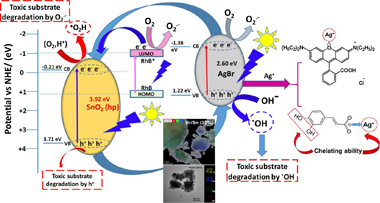
Abstract
Composites (AgBr/SnO2) comprised of AgBr and SnO2 with different molar % of bare SnO2, have been synthesized by simple precipitation methods; the bare SnO2 used, was synthesized by hydrothermal procedure. Samples have been characterized by X-ray diffraction (XRD), N2-adsorption, UV–vis diffuse reflectance spectroscopy (DRS), scanning electron microscopy (SEM), Transmission electron microscopy (TEM) and X-ray photoelectron spectroscopy (XPS). Photocatalytic activity of the as-prepared photocatalysts was evaluated through photocatalytic degradation of rhodamine B (RhB) and caffeic acid (CAFA) under UV and Visible illumination. In photocatalytic degradation studies, for both substrates, conversion rates of around 95% were found in 45 min of both UV-illumination and 85% under visible lighting. These conversion rates were superior than the conversion rates of pure parental components, AgBr and SnO2 under the same experimental conditions. At least, for RhB no loss of photocatalytic activity has been observed after five recycles although the mineralization degree progressively diminished along the recycles. The enhanced photocatalytic degradation of AgBr/SnO2 compounds was attributed, in part, to a synergistic increase in adsorption viability, as well as to the effective separation of photoinduced load carriers that resulted from the formation of a heterojunction according to the type II junction. Radical scavengers’ experiments indicated that active oxidant species as O2.−, ·OH and h+ all are involved in this photocatalytic system, although it seems that O2.− played the major role in the photocatalytic degrading of RhB by AgBr/SnO2 composites. In summary, coupling AgBr with SnO2 remarkably improves the photocatalytic activity under both UV and visible-illumination with respect to the parental components. These features open the route to future applications of this material in the field of environmental remediation.
February, 2021 · DOI: 10.1016/j.seppur.2020.117948
Reactividad de Sólidos
Influence of Successive Chemical and Thermochemical Treatments on Surface Features of Ti6Al4V Samples Manufactured by SLM
Gonzalez, JE; de Armas, G; Negrin, J; Beltran, AM; Trueba, P; Gotor, FJ; Peon, E; Torres, YMetals, 11 (2021) 313 DOI: 10.3390/met11020313
Abstract
Ti6Al4V samples, obtained by selective laser melting (SLM), were subjected to successive treatments: acid etching, chemical oxidation in hydrogen peroxide solution and thermochemical processing. The effect of temperature and time of acid etching on the surface roughness, morphology, topography and chemical and phase composition after the thermochemical treatment was studied. The surfaces were characterized by scanning electron microscopy, energy dispersive X-ray spectroscopy, X-ray diffraction and contact profilometry. The temperature used in the acid etching had a greater influence on the surface features of the samples than the time. Acid etching provided the original SLM surface with a new topography prior to oxidation and thermochemical treatments. A nanostructure was observed on the surfaces after the full process, both on their protrusions and pores previously formed during the acid etching. After the thermochemical treatment, the samples etched at 40 °C showed macrostructures with additional submicro and nanoscale topographies. When a temperature of 80 °C was used, the presence of micropores and a thicker anatase layer, detectable by X-ray diffraction, were also observed. These surfaces are expected to generate greater levels of bioactivity and high biomechanics fixation of implants as well as better resistance to fatigue.
February, 2021 · DOI: 10.3390/met11020313
Química de Superficies y Catálisis
Guaiacol hydrodeoxygenation in hydrothermal conditions using N-doped reduced graphene oxide (RGO) supported Pt and Ni catalysts: Seeking for economically viable biomass upgrading alternatives
Parrilla-Lahoz, S; Jin, W; Pastor-Perez, L; Carrales-Alvarado, D; Odriozola, JA; Dongil, AB; Reina, TRApplied Catalysis A-General, 611 (2021) 117977 DOI: 10.1016/j.apcata.2020.117977
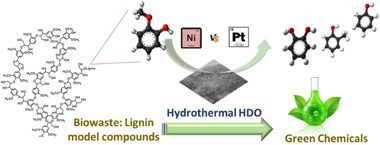
Abstract
Herein we present an innovative route for model biomass compounds upgrading via “H2-free” hydrodeoxygenation (HDO) reactions. The underlaying idea is to implement a multifunctional catalyst able to activate water and subsequently use in-situ generated hydrogen for the HDO process. In this sense we have developed a series of effective Ni and Pt based catalysts supported on N-promoted graphene decorated with ceria. The catalyst reached commendable conversion levels and selectivity to mono-oxygenated compounds considering the very challenging reaction conditions. Pt outperforms Ni when the samples are tested as-prepared. However, Ni performance is remarkably boosted upon applying a pre-conditioning reductive treatment. Indeed, our NiCeO2/GOr-N present the best activity/selectivity balance and it is deemed as a promising catalyst to conduct the H2-free HDO reaction. Overall, this “proof-concept” showcases an economically appealing route for bio-compounds upgrading evidencing the key role of advanced catalysts for a low carbon future.
February, 2021 · DOI: 10.1016/j.apcata.2020.117977
Collagen Type I Biomaterials as Scaffolds for Bone Tissue Engineering
Rico-Llanos, GA; Borrego-Gonzalez, S; Moncayo-Donoso, M; Becerra, J; Visser, RPolymers, 13 (2021) art599 DOI: 10.3390/polym13040599
Abstract
Collagen type I is the main organic constituent of the bone extracellular matrix and has been used for decades as scaffolding material in bone tissue engineering approaches when autografts are not feasible. Polymeric collagen can be easily isolated from various animal sources and can be processed in a great number of ways to manufacture biomaterials in the form of sponges, particles, or hydrogels, among others, for different applications. Despite its great biocompatibility and osteoconductivity, collagen type I also has some drawbacks, such as its high biodegradability, low mechanical strength, and lack of osteoinductive activity. Therefore, many attempts have been made to improve the collagen type I-based implants for bone tissue engineering. This review aims to summarize the current status of collagen type I as a biomaterial for bone tissue engineering, as well as to highlight some of the main efforts that have been made recently towards designing and producing collagen implants to improve bone regeneration.
February, 2021 · DOI: 10.3390/polym13040599
Nanotecnología en Superficies y Plasma - Tribología y Protección de Superficies
Patterning and control of the nanostructure in plasma thin films with acoustic waves: mechanical vs. electrical polarization effects
García-Valenzuela, A.; Fakhouri, A.; Oliva-Ramírez, M.; Rico-Gavira, V.; Rojas, T.C.; Alvarez, R.; Menzel, S.B.; Palmero, A.; Winkler, A.; González-Elipe, A.R.Materials Horizons, 8 (2021) 515-524 DOI: 10.1039/D0MH01540G

Abstract
Nanostructuration and 2D patterning of thin films are common strategies to fabricate biomimetic surfaces and components for microfluidic, microelectronic or photonic applications. This work presents the fundamentals of a surface nanotechnology procedure for laterally tailoring the nanostructure and crystalline structure of thin films that are plasma deposited onto acoustically excited piezoelectric substrates. Using magnetron sputtering as plasma technique and TiO2 as case example, it is demonstrated that the deposited films depict a sub-millimetre 2D pattern that, characterized by large lateral differences in nanostructure, density (up to 50%), thickness, and physical properties between porous and dense zones, reproduces the wave features distribution of the generated acoustic waves (AW). Simulation modelling of the AW propagation and deposition experiments carried out without plasma and under alternative experimental conditions reveal that patterning is not driven by the collision of ad-species with mechanically excited lattice atoms of the substrate, but emerges from their interaction with plasma sheath ions locally accelerated by the AW-induced electrical polarization field developed at the substrate surface and growing film. The possibilities of the AW activation as a general approach for the tailored control of nanostructure, pattern size, and properties of thin films are demonstrated through the systematic variation of deposition conditions and the adjustment of AW operating parameters.
February, 2021 · DOI: 10.1039/D0MH01540G
Materiales Coloidales
Dysprosium and Holmium Vanadate Nanoprobes as High-Performance Contrast Agents for High-Field Magnetic Resonance and Computed Tomography Imaging
Gomez-Gonzalez, E; Nunez, NO; Caro, C; Garcia-Martin, ML; Fernandez-Afonso, Y; de la Fuente, JM; Balcerzyk, M; Ocana, MInorganic Chemistry, 60 (2021) 152-160 DOI: 10.1021/acs.inorgchem.0c02601
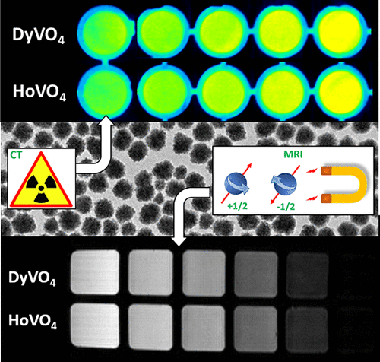
Abstract
We describe a wet chemical method for the synthesis of uniform and well-dispersed dysprosium vanadate (DyVO4) and holmium vanadate (HoVO4) nanoparticles with an almost spherical shape and a mean size of ∼60 nm and their functionalization with poly(acrylic acid). The transverse magnetic relaxivity of both systems at 9.4 T is analyzed on the basis of magnetic susceptibility and magnetization measurements in order to evaluate their potential for application as high-field MRI contrast agents. In addition, the X-ray attenuation properties of these systems are also studied to determine their capabilities as computed tomography contrast agent. Finally, the colloidal stability under physiological pH conditions and the cytotoxicity of the functionalized NPs are also addressed to assess their suitability for bioimaging applications.
January, 2021 · DOI: 10.1021/acs.inorgchem.0c02601
Materiales Ópticos Multifuncionales
Enhanced Directional Light Extraction from Patterned Rare-Earth Phosphor Films
Cabello-Olmo, E; Molet, P; Mihi, A; Lozano, G; Miguez, HAdvanced Optical Materials, 9 (2021) 2001611 DOI: 10.1002/adom.202001611
Abstract
The combination of light‐emitting diodes (LEDs) and rare earth (RE) phosphors as color‐converting layers comprises the basis of solid‐state lighting. Indeed, most LED lamps include a photoluminescent coating made of phosphor material, i.e., crystalline matrix suitably doped with RE elements, to produce white light from a blue or ultraviolet LED chip. Transparent phosphor‐based films constitute starting materials for new refined emitters that allow different photonic designs to be implemented. Among the different photonic strategies typically employed to tune or enhance emission, surface texturing has proved its versatility and feasibility in a wide range of materials and devices. However, most of the nanofabrication techniques cannot be applied to RE phosphors directly because of their chemical stability or because of their cost. The first monolithic patterned structure of down‐shifting nanophosphors with square arrays of nanoholes with different lattice parameters is reported in this study. It is shown that a low‐cost soft‐nanolithography procedure can be applied to red‐emitting nanophosphors (GdVO4:Eu3+ nanocrystals) to tune their emission properties, attaining a twofold directional enhancement of the emitted light at predesigned emission wavelengths in specific directions.
January, 2021 · DOI: 10.1002/adom.202001611
Materiales Ópticos Multifuncionales
Disentangling Electron–Phonon Coupling and Thermal Expansion Effects in the Band Gap Renormalization of Perovskite Nanocrystals
Rubino, A; Francisco-Lóprez, A.; Baker, A.J., Petrozza, A.; Calvo, M.E.; Goñi, A.R.; Míguez, H.Journal of Physical Chemistry Letters, 12 (2021) 569-575 DOI: 10.1021/acs.jpclett.0c03042
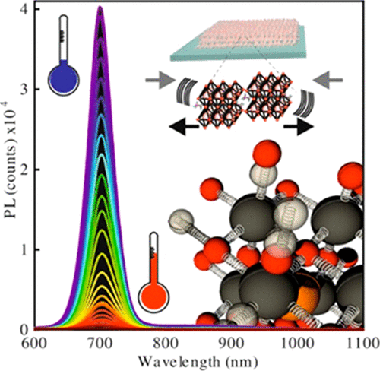
Abstract
The complex electron–phonon interaction occurring in bulk lead halide perovskites gives rise to anomalous temperature dependences, like the widening of the electronic band gap as temperature increases. However, possible confinement effects on the electron–phonon coupling in the nanocrystalline version of these materials remain unexplored. Herein, we study the temperature (ranging from 80 K to ambient) and hydrostatic pressure (from atmospheric to 0.6 GPa) dependence of the photoluminescence of ligand-free methylammonium lead triiodide nanocrystals with controlled sizes embedded in a porous silica matrix. This analysis allowed us to disentangle the effects of thermal expansion and electron–phonon interaction. As the crystallite size decreases, the electron–phonon contribution to the gap renormalization gains in importance. We provide a plausible explanation for this observation in terms of quantum confinement effects, showing that neither thermal expansion nor electron–phonon coupling effects may be disregarded when analyzing the temperature dependence of the optoelectronic properties of perovskite lead halide nanocrystals.
January, 2021 · DOI: 10.1021/acs.jpclett.0c03042
Reactividad de Sólidos
Critical Influence of the Processing Route on the Mechanical Properties of Zirconia Composites with Graphene Nanoplatelets
Gallardo-Lopez, A; Munoz-Ferreiro, C; Lopez-Pernia, C; Jimenez-Pique, E; Gutierrez-Mora, F; Morales-Rodriguez, A; Poyato, RMaterials, 14 (2021) 108 DOI: 10.3390/ma14010108
Abstract
Graphene-based nanostructures, used as potential reinforcement in ceramic composites, have a great tendency to agglomerate. This requires the use of homogenization techniques during the powder processing, posing the need to evaluate how these techniques affect the microstructure and the mechanical properties of the resulting composites. The influence of the processing route on the properties of 3YTZP (3 mol % yttria tetragonal zirconia polycrystals) ceramic composites with 10 vol % cost-effective GNP (graphene nanoplatelets) has been addressed. Four different powder processing routines combining ultrasonic powder agitation (UA) and planetary ball milling (PBM) in wet and dry media have been used and all the composites were densified by spark plasma sintering (SPS). The mechanical properties at room temperature in the macroscale have been assessed by Vickers indentations, four-point bending tests and the impulse-echo technique, while instrumented indentation was used to measure the hardness and Young’s modulus at the nanoscale. The application of dry-PBM enhances greatly the mechanical and electrical isotropy of the composites, slightly increases the hardness and lowers the elastic modulus, independently of the application of UA. The combination of UA and dry-PBM enhances the flexure strength by 50%, which is desirable for structural applications.
January, 2021 · DOI: 10.3390/ma14010108
Fotocatálisis Heterogénea: Aplicaciones
Sol-gel synthesis of ZnWO4-(ZnO) composite materials. Characterization and photocatalytic properties
Jaramillo-Páez, C., Navío, J.A., Puga, F., Hidalgo, M.C.Journal of Photochemistry & Photobiology, A: Chemistry, 404 (2021) 112962 DOI: 10.1016/j.jphotochem.2020.112962

Abstract
ZnWO4 based powder photocatalyst have been successfully prepared by calcining a co-precipitated precursor (ZnWO) obtained from aqueous Zn2+ and WO4 2− solutions at pH = 7, without surfactants addition. The as-formed sample was characterized by XRD, N2-absorption, SEM, TEM, DRS and XPS. Both techniques, XRD and XPS results showed that prepared sample corresponds to a crystalline, Zn-enriched composition, ZnWO4 indicating the formation of a ZnWO4-(ZnO) composite, whit ca. 10 wt.-% of ZnO confirmed by XRF analysis. Photocatalytic activities towards degradation of Rhodamine B (RhB), Methyl Orange (MO) and Phenol, under UV-illumination, was investigated not only by monitoring the percentages of conversion of substrates, but also by estimating the corresponding percentages of mineralization that accompany the photocatalytic process. Comparative substrateconversion rates estimated per surface area unit of catalyst, showed that the activity for ZnWO4-(ZnO) composite is similar to that for TiO2(P25), at least for MO and RhB, and even higher that for TiO2(P25) in respect to phenol conversion. By adding TEA to the synthesis procedure, a composite named as ZnWO4-ZnO-(pH = 10)-600 is generated, which has a higher proportion of ZnO (ca. 39 %) and superior specific surface area than the so-called ZnWO4-(ZnO) sample. Furthermore, the photocatalytic degradation of MO using the former material indicates that it is superior to ZnWO4-(ZnO) and even that TiO2(P25) itself under the same operational conditions.
January, 2021 · DOI: 10.1016/j.jphotochem.2020.112962
Nanotecnología en Superficies y Plasma
Physicochemical surface analysis and germination at different irrigation conditions of DBD plasma‐treated wheat seeds
Molina, R; Lalueza, A; Lopez-Santos, C; Ghobeira, R; Cools, P; Morent, R; de Geyter, N; Gonzalez-Elipe, ARPlasma Processes and Polymers, 18 (2021) e2000086 DOI: 10.1002/ppap.202000086
Abstract
Plasma treatment is increasingly being explored as an effective presowing treatment improving seed germination. This study examines the synergetic effect of the irrigation condition and the physicochemical surface properties of wheat seeds subjected to atmospheric dielectric barrier discharge plasma activation on their water uptake and germination. Extensive surface analysis revealed a remarkably enhanced wettability of plasma-treated seeds due to the insertion of oxygen-containing functionalities on their surface. However, long plasma exposures damaged the outermost layers of the pericarp due to a pronounced oxidative etching effect. Although the seed germination capacity was not affected by the plasma treatments, short plasma exposures were shown to enhance water uptake and accelerate seed germination, especially under water-scarcity conditions.
January, 2021 · DOI: 10.1002/ppap.202000086
- ‹ previous
- 10 of 37
- next ›




